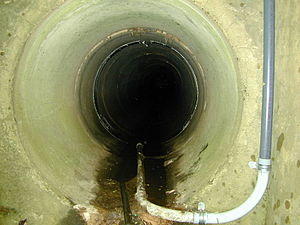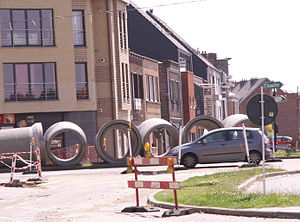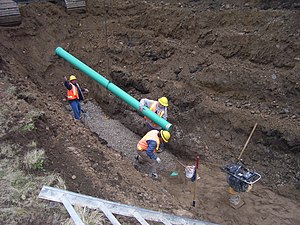| This article needs additional citations for verification. Please help improve this article by adding reliable references. Unsourced material may be challenged and removed. (September 2007) |

Image of a pipe

A sewer-pipe being laid by the city's sewerage company

A manhole cover for a sewage system

PVC Sanitary Sewer Installation
A sanitary sewer (also called a foul sewer) is a type of an underground carriage system, (the 'system of sewers' is called sewerage), for transporting sewage from houses or industry to treatment or disposal. In some areas, sanitary sewers are separate sewer systems specifically for the carrying of domestic and industrial wastewater, and are operated separately and independently of storm drains, which carry the runoff of rain and other water which wash into city streets.[1]:Ch.I [2] Sewers carrying both sewage and stormwater together are called combined sewers.
In the twenty-first century developed world, sewers are usually pipelines that begin with connecting pipes from buildings to one or more levels of larger underground trunk mains, which transport the sewage to sewage treatment facilities. Vertical pipes, called manholes, connect the mains to the surface. The manholes are used for access to the sewer pipes for inspection and maintenance. They also facilitate vertical and horizontal angles in otherwise straight pipelines. Sewers are generally gravity powered, though pumps may be used if necessary. The most commonly used sanitary pipe is SDR-35 (standard dimension ratio), with smaller sized laterals interconnected within a larger sized main.[citation needed]
History[]
The earliest covered sewers uncovered by archaeologists are in the regularly planned cities of the Indus Valley Civilization. In ancient Rome, the Cloaca Maxima, considered a marvel of engineering, disgorged into the Tiber. In ancient China, sewers existed in various cities such as Linzi. In medieval European cities, small natural waterways used for carrying off wastewater were eventually covered over and functioned as sewers. London's River Fleet is such a system. Open drains along the center of some streets were known as 'kennels' (= canals, channels). The nineteenth century brick-vaulted sewer system of Paris (The Paris sewers) offers tours for tourists.
As an outgrowth of the Industrial Revolution, many cities in Europe and North America grew in the 19th century, frequently leading to crowding and increasing concerns about public health.[3] As part of a trend of municipal sanitation programs in the late 19th and 20th centuries, many cities constructed extensive sewer systems to help control outbreaks of disease such as typhoid and cholera.[2]:29-34 Initially these systems discharged sewage directly to surface waters without treatment. As pollution of water bodies became a concern, cities added sewage treatment plants to their systems.
Simplified sewers[]
Simplified sanitary sewers consist of small-diameter pipes (typically 100 mm or about 4 inches), often laid at fairly flat gradients (1 in 200). The investment cost for sanitary sewers can be about half the costs of conventional sewers. However, the requirements for operation and maintenance are usually higher. Simplified sewers are most common in Brazil and are also used in a number of other developing countries.
Implementation and usefulness[]

The several types of sewerage systems
In many European countries, citizens are obliged to connect their home sanitation to the national sewerage system (where possible). This has resulted in large percentages of the population being connected to a sewerage system. For example, the Netherlands have 99% of the population connected to the sewerage system, and 1% has an individual excrement disposal system (eg septic tank, ...). Others have slightly lower (though still substantial) percentages; eg 96% for Germany and 86% for Belgium.
Of these countries connected to the sewerage system however, purification of the sewerage is not always fully implemented. For example, in Belgium, only 64% of the sewerage is actually purified.[4]
Given the great financial costs of a sewerage system however, much of the excrement is not efficiently (and sometimes not at all) recycled, and (in case no purification is implemented) great environmental damage may occur using this system. Many people [5][6]have thus opted to discontinue the setup of the system in nations/areas where no sewerage has yet been build. In addition, even in nations where the system has been set up, calls have been made to keep the system to drain rainwater, yet implement composting toilets to process the faeces.
Sewers in popular culture[]
The image of the sewer recurs in European culture as they were often used as hiding places or routes of escape by the scorned or the hunted, including partisans and resistance fighters in WWII. Fighting erupted in the sewers during the Battle of Stalingrad. The only survivors from the Warsaw Uprising and Warsaw Ghetto made their final escape through city sewers. Some have commented that the engravings of imaginary prisons by Piranesi were inspired by the Cloaca Maxima, one of the world's earliest sewers.
Sewers in fiction[]
The theme of traveling through, hiding, or even residing in sewers is a common cliché in media. Famous examples of sewer dwelling or scenes are Teenage Mutant Ninja Turtles, Stephen King's It, Les Miserables, The Third Man, Ladyhawke, Mimic, The Phantom of the Opera, Beauty and the Beast, and Jet Set Radio Future.
Sewer alligators[]
- Main article: Sewer alligator
A well-known urban legend, the sewer alligator, is that of giant alligators or crocodiles residing in sewers, especially of major metropolitan areas. Two public sculptures in New York depict an alligator dragging a hapless victim into a manhole.[7]
Alligators have been known to get into combined storm sewers in the Southeastern United States. Closed-circuit television by a sewer repair company captured an alligator in a combined storm sewer on tape.[8]
See also[]
- Buchan trap
- Combined sewer
- Sanitary sewer overflow (SSO)
- Sewage treatment
- Stormwater
- Water pollution
- Composting toilet
References[]
- ↑ Leonard Metcalf, Harrison P. Eddy (1922). Sewerage and Sewage Disposal: A Textbook. (New York: McGraw-Hill.)
- ↑ 2.0 2.1 Cady Staley, George S. Pierson (1899). The Separate System of Sewerage, Its Theory and Construction. (New York: Van Nostrand.)
- ↑ Steven J. Burian, Stephan J. Nix, Robert E. Pitt, and S. Rocky Durrans (2000). "Urban Wastewater Management in the United States: Past, Present, and Future." Journal of Urban Technology, Vol. 7, No. 3, pp. 33-62. Template:DOI.
- ↑ Kijk magazine, november 2009
- ↑ Gatze Littinga discouraging use of sewerage system in areas without it
- ↑ SuSanA discouraging use of sewerage system in areas without it
- ↑ Subway Art: New York's Underground Treasures : NPR
- ↑ YouTube - Bad sewer pipes across America
External links[]
| Wikimedia Commons has media related to Sanitary sewer that may be added |
- Experiences and Challenges in Sewers: Measurements and Hydrodynamics (2008), International Meeting on Measurements and Hydraulics of Sewers IMMHS'08, Hydraulic Model Report No. CH70/08, University of Queensland, Brisbane, Australia, 114 pages (ISBN 9781864999280)
| |||||||||||||||||||||||||
az:Kanalizasiya cs:Stoková síť da:Kloak (byplan) de:Kanalisation es:Alcantarillado eo:Kloako (kanalo) fr:Canalisation gl:Rede de sumidoiros it:Fognatura he:ביוב lt:Nuotakynas ms:Pembetung sanitari nl:Riool ja:下水道 pl:Kanalizacja pt:Efluente ro:Canalizare ru:Канализация sq:Kanalizimi scn:Cunnuttu (fogna) simple:Sewer sk:Kanalizácia sh:Kanalizacija fi:Viemäri sv:Avlopp tr:Kanalizasyon uk:Каналізація vi:Hệ thống thoát nước zh:下水道